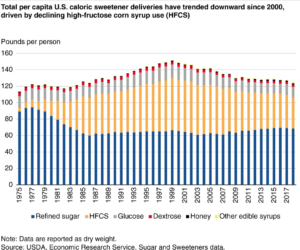Join Health Affairs for a virtual conversation between me and Angela Odoms-Young of Cornell University discussing the evolution of US food and nutrition policy, the current policy landscape, and thoughts on what lies ahead. It’s at 1:00 p.m. EDT. To join the Webinar, click here.
What’s up with sugars?
I’m still seeing articles coming out from the USDA’s Economic Research Service, now sadly moved to Kansas City. This one is based on an older article.* It’s about how “consumption” of sugars (in quotes because the data actually reflect the availability of sugars in the food supply—production less exports plus imports).

Here’s how I read this chart:
- Overall sugars are down almost to the level of the late 1970s.
- Refined (table) sugar dropped at about the time High Fructose Corn Syrup (HFCS) became widely used; it is holding steady.
- HFCS accounted for the increase in total sugars from 1975-1999. The subsequent decline is also mainly in HFCS.
The big reason for the decline is lower consumption of soft drinks (these account for nearly half total sugars consumed).
Another trend is substitution of HFCS by table sugar. This is to the higher cost of HFCS relative to table sugar. It used to be much cheaper but increased demand for corn to produce ethanol has made HFCS and table sugar cost about the same.
Also, HFCS has a reputation for being worse for health than table sugar, but they are about the same physiologically. HFCS is glucose and fructose separated. Table sugar is glucose and fructose stuck together (but quickly separated in the body).
I’m all for eating less of either one. This, at least, is a healthy trend.
*Sugar and Sweeteners Outlook: July 2019 , by Michael McConnell and David W. Olson, ERS, July 2019

